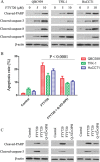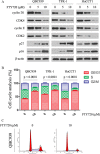FTY720 inhibits proliferation and epithelial-mesenchymal transition in cholangiocarcinoma by inactivating STAT3 signaling
- PMID: 25344679
- PMCID: PMC4221672
- DOI: 10.1186/1471-2407-14-783
FTY720 inhibits proliferation and epithelial-mesenchymal transition in cholangiocarcinoma by inactivating STAT3 signaling
Abstract
Background: Interleukin 6 (IL-6)-mediated signal transducers and activators of transcription 3 (STAT-3) phosphorylation (activation) is aberrantly sustained in cholangiocarcinoma cells resulting in enhanced myeloid cell leukemia 1 (Mcl-1) expression and resistance to apoptosis. FTY720, a new immunosuppressant, derived from ISP-1, has been studied for its putative anti-cancer properties. This study aimed to elucidate the mechanism by which FTY720 mediates antitumor effects in cholangiocarcinoma (CC) cells.
Methods: Three CC cell lines were examined, QBC939, TFK-1, and HuCCT1. The therapeutic effects of FTY720 were evaluated in vitro and in vivo. Cell proliferation, apoptosis, cell cycle, invasive potential, and epithelial- mesenchy-mal transition (EMT) were examined.
Results: FTY720 greatly inhibited CC cells proliferation and EMT in vitro and in vivo, and this effect was associated with dephosphorylation of STAT3tyr705. FTY720 induced apoptosis and G1 phase arrest in CC cells, and inhibited invasion of CC cells. Western blot analysis showed that FTY720 induced cleavage of caspases 3, 8 and 9, and of PARP, in a dose-dependent manner, consistent with a substantial decrease in p-STAT3, Bcl-xL, Bcl-2, survivin, cyclin D1, cyclin E, N-cadherin, vimentin, VEGF and TWIST1. In vivo studies showed that tumor growth and metastasis were significantly suppressed after FTY720 treatment.
Conclusions: These results suggest that FTY720 induces a significant decrease in p-STAT3, which inhibits proliferation and EMT of CC cells, and then induces G1 phase arrest and apoptosis. We have characterized a novel immunosuppressant, which shows potential anti-tumor effects on CC via p-STAT3 inhibition. FTY720 merits further investigation and warrants clinical evaluation.
Figures






Similar articles
-
PTEN- and p53-mediated apoptosis and cell cycle arrest by FTY720 in gastric cancer cells and nude mice.J Cell Biochem. 2010 Sep 1;111(1):218-28. doi: 10.1002/jcb.22691. J Cell Biochem. 2010. PMID: 20506484
-
Enhanced expression of suppresser of cytokine signaling 3 inhibits the IL-6-induced epithelial-to-mesenchymal transition and cholangiocarcinoma cell metastasis.Med Oncol. 2015 Apr;32(4):105. doi: 10.1007/s12032-015-0553-7. Epub 2015 Mar 6. Med Oncol. 2015. PMID: 25744243
-
Allicin Inhibits Proliferation and Invasion in Vitro and in Vivo via SHP-1-Mediated STAT3 Signaling in Cholangiocarcinoma.Cell Physiol Biochem. 2018;47(2):641-653. doi: 10.1159/000490019. Epub 2018 May 22. Cell Physiol Biochem. 2018. PMID: 29794468
-
Signal transducer and activator of transcription-3, inflammation, and cancer: how intimate is the relationship?Ann N Y Acad Sci. 2009 Aug;1171:59-76. doi: 10.1111/j.1749-6632.2009.04911.x. Ann N Y Acad Sci. 2009. PMID: 19723038 Free PMC article. Review.
-
Cellular and Molecular Mechanisms Modulated by Genistein in Cancer.Int J Mol Sci. 2025 Jan 27;26(3):1114. doi: 10.3390/ijms26031114. Int J Mol Sci. 2025. PMID: 39940882 Free PMC article. Review.
Cited by
-
Targeting Epithelial-to-Mesenchymal Transition in Radioresistance: Crosslinked Mechanisms and Strategies.Front Oncol. 2022 Feb 16;12:775238. doi: 10.3389/fonc.2022.775238. eCollection 2022. Front Oncol. 2022. PMID: 35251963 Free PMC article. Review.
-
Stattic Enhances Radiosensitivity and Reduces Radio-Induced Migration and Invasion in HCC Cell Lines through an Apoptosis Pathway.Biomed Res Int. 2017;2017:1832494. doi: 10.1155/2017/1832494. Epub 2017 Oct 26. Biomed Res Int. 2017. PMID: 29226125 Free PMC article.
-
Role of the PP2A Pathway in Cholangiocarcinoma: State of the Art and Future Perspectives.Cancers (Basel). 2022 Nov 3;14(21):5422. doi: 10.3390/cancers14215422. Cancers (Basel). 2022. PMID: 36358840 Free PMC article.
-
The emerging role of FTY720 (Fingolimod) in cancer treatment.Oncotarget. 2016 Apr 26;7(17):23106-27. doi: 10.18632/oncotarget.7145. Oncotarget. 2016. PMID: 27036015 Free PMC article. Review.
-
Targeting the Sphingosine Kinase/Sphingosine-1-Phosphate Signaling Axis in Drug Discovery for Cancer Therapy.Cancers (Basel). 2021 Apr 15;13(8):1898. doi: 10.3390/cancers13081898. Cancers (Basel). 2021. PMID: 33920887 Free PMC article. Review.
References
Pre-publication history
-
- The pre-publication history for this paper can be accessed here:http://www.biomedcentral.com/1471-2407/14/783/prepub
Publication types
MeSH terms
Substances
LinkOut - more resources
Full Text Sources
Other Literature Sources
Research Materials
Miscellaneous

